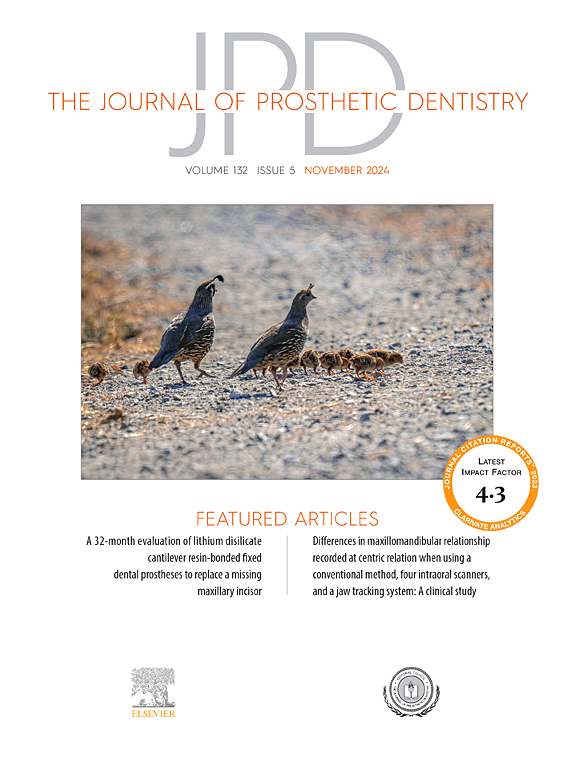骨质受损患者的种植牙和骨质增生治疗:与口腔健康相关的生活质量结果
IF 4.3
2区 医学
Q1 DENTISTRY, ORAL SURGERY & MEDICINE
引用次数: 0
摘要
问题陈述:患者报告的结果是牙科植入物和骨增量治疗的一个额外且经常被忽视的衡量标准。目的:这项队列研究的目的是评估骨密度正常或轻度骨质疏松症("健康 "组;股骨颈、全髋和 L1-L4 脊柱的所有 DXA T 值均>-2.0)与中度骨质疏松症或骨质疏松症("骨质疏松症 "组;股骨颈、全髋和 L1-L4 脊柱的所有 DXA T 值均>-2.0)绝经后妇女接受牙科植入物治疗后的口腔健康相关生活质量(OHRQoL)。材料和方法:康涅狄格大学牙医学院共招募了 115 名患者,作为标准护理、前瞻性、非随机队列研究的一部分。所有参与者都接受了三种骨质增生手术中的一种,并植入了种植体。在基线和植入种植体后的不同时间段,我们使用口腔健康影响档案-14(OHIP-14)以及患者期望和满意度调查来测量患者的口腔健康质量生活水平(OHRQoL)。这些指标在健康组和骨受损组之间进行了比较(α=0.05):对于线性混合效应模型中的所有 OHRQoL 指标,骨质组之间在基线和植入种植体后的每个时间点均无显著差异(P>.05)。根据 OHIP-14 的最小重要差异 (MID),在种植体植入后的所有时间点,骨组之间的患者结果均未发现明确的临床差异(P>.05)。从基线到种植体植入后 24 个月,健康组和骨质受损组在 OHIP-14 和患者期望值评分方面都有显著改善(PC 结论:通过OHIP-14、患者期望值和患者满意度调查得出的患者报告结果显示,健康组和骨质受损组在种植后的OHRQoL改善情况相似。骨质组间的 OHRQoL 改善在持续性和范围上都相似,在植入种植体后 24 个月时,在所有测量指标上都没有证据表明组间存在具有统计学意义的分数差异,在所有时间点的 OHIP-14 MID 比较中也没有确切证据表明存在临床差异。本文章由计算机程序翻译,如有差异,请以英文原文为准。
Dental implant and bone augmentation treatment in bone-compromised patients: Oral health-related quality of life outcomes
Statement of problem
Patient-reported outcomes represent an additional and often overlooked measure of dental implant and bone augmentation treatment. Few implant studies have evaluated patient-reported outcomes in those with systemic bone compromise.
Purpose
The purpose of this cohort study was to assess oral health-related quality of life (OHRQoL) outcomes in postmenopausal women receiving dental implants with normal bone density or mild osteopenia (“healthy” group; all DXA T-scores at femoral neck, total hip, and L1-L4 spine>−2.0) versus moderate osteopenia or osteoporosis (“bone compromised” group; any DXA T-score at femoral neck, total hip, or L1-L4 spine≤−2.0).
Material and methods
A total of 115 patients were recruited at the University of Connecticut School of Dental Medicine as part of a standard of care, prospective, nonrandomized cohort study. All participants received 1 of 3 bone augmentation procedures with implant placement. At baseline and at various intervals after implant placement, OHRQoL was measured by using the Oral Health Impact Profile-14 (OHIP-14) and surveys of patient expectations and satisfaction. These measures were compared between healthy and bone compromised groups (α=.05).
Results
For all OHRQoL measures across linear mixed effects models, no significant differences were found between bone groups at baseline and at each time point after implant placement (P>.05). Using the minimally important difference (MID) for OHIP-14, no definitive clinical differences were found in patient outcomes between bone groups at all postimplant time points (P>.05). From baseline to 24 months after implant placement, both healthy and bone compromised groups exhibited significant improvements in OHIP-14 and patient expectations scores (P<.05). While no within group differences were found in patient satisfaction scores, the mean satisfaction score remained high over time in both groups.
Conclusions
Patient-reported outcomes as measured through OHIP-14, patient expectations, and patient satisfaction surveys suggest similar postimplant OHRQoL improvement in healthy and bone compromised individuals. OHRQoL improvements between bone groups were similar both in continuity and in scope, with no evidence of statistically significant score differences between groups at 24 months after implant placement across all measures and with no definitive evidence of clinical differences as measured by OHIP-14 MID comparisons across all timepoints.
求助全文
通过发布文献求助,成功后即可免费获取论文全文。
去求助
来源期刊

Journal of Prosthetic Dentistry
医学-牙科与口腔外科
CiteScore
7.00
自引率
13.00%
发文量
599
审稿时长
69 days
期刊介绍:
The Journal of Prosthetic Dentistry is the leading professional journal devoted exclusively to prosthetic and restorative dentistry. The Journal is the official publication for 24 leading U.S. international prosthodontic organizations. The monthly publication features timely, original peer-reviewed articles on the newest techniques, dental materials, and research findings. The Journal serves prosthodontists and dentists in advanced practice, and features color photos that illustrate many step-by-step procedures. The Journal of Prosthetic Dentistry is included in Index Medicus and CINAHL.
 求助内容:
求助内容: 应助结果提醒方式:
应助结果提醒方式:


